A brief history: The Smithsonian was created in 1838 with a gift from James Smithson, an English scientist who had never been to America. He finally made it to the good old U.S.A. in the early 1900s. . . when his remains were reinterred in the Smithsonian Castle. His final resting place in Genoa, Italy became a temporary one when the city decided it wanted the cemetery land for other purposes, so Alexander Graham Bell was sent to fetch Smithson's remains.
No one knows why he gave his fortune- $50,000- to the U.S. The gift was contingent on his nephew dying without an heir, which Smithson probably didn't think would happen, since his nephew was only 16 at the time of its death. But fate doesn't always work the way we expect, so let's thank that funny little codicil for all these museums that we can visit for free.
The Smithsonian has earned every bit of its reputation as the Nation's Attic. The Smithsonian Castle, which once housed the entire collection, is now just the welcome and information center for the 18-museum institute. The Castle still has some display space with bits and pieces from its various museums, such as:
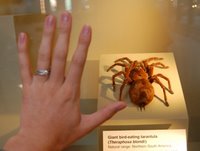 A Giant Bird-Eating Tarantula. It's as big as my hand, and my hands are big enough to palm a men's basketball. (In this picture, my hand is still about 2 feet away from the spider) The description said that it was raised in captivity and spent most of its life in the Natural History Museum Bug Zoo. I'm guessing it wasn't included in the bug petting zoo. Spiders don't have very good eyesight and a little toddler hand is approximately the same size as a sparrow.
A Giant Bird-Eating Tarantula. It's as big as my hand, and my hands are big enough to palm a men's basketball. (In this picture, my hand is still about 2 feet away from the spider) The description said that it was raised in captivity and spent most of its life in the Natural History Museum Bug Zoo. I'm guessing it wasn't included in the bug petting zoo. Spiders don't have very good eyesight and a little toddler hand is approximately the same size as a sparrow.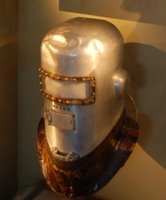
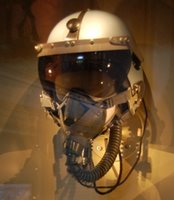
Helmets: a) the first experimental pressure suit helmet from 1933 and b) Chuck Yeager's helmet, worn while breaking the speed of sound. The experimental helmet looks like a cheap aluminum pot (notice the dents) with a viewing slot cut in it. Luckily for General Yeager, technology advanced before his time or his sound-breaking flight could have been a head-shrinker.
Natural History Museum
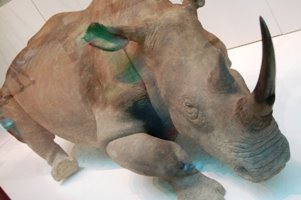 According to the Smithsonian, the white rhinoceros is a "highly endangered" species. The display also notes that "Former President Theodore Roosevelt collected this specimen in 1909."
According to the Smithsonian, the white rhinoceros is a "highly endangered" species. The display also notes that "Former President Theodore Roosevelt collected this specimen in 1909."This wording suggests to the casual reader that the president just happened upon a white rhinoceros. Maybe he was out for a morning stroll, saw a rhino lying by the road, and picked it up for the education and general betterment of the American people. Riiiight.
Or perhaps President Roosevelt, an outdoor enthusiast and big game hunter, shot this very rhino, probably also posing for photos over its gigantic, now-endangered body. We just have to remember that it was perfectly acceptable for the leader of our country to shoot everything in sight at the turn of the last century. I'm sure Dick Cheney wishes that were still the case.
Air & Space Museum
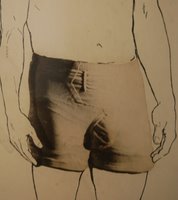
Another instance of the Smithsonian playing a funny moment in history totally straight is this display of the "Fecal Containment
System" used by the astronauts. That's right, Buzz Aldrin had emergency poop pants. According to the display, the Depends precursors were "for emergency containment of solid waste matter when spacecraft facilities are inconvenient." You can see the curator's mind working: "Maybe if we use nebulous phrases like 'emergency containment of solid waste matter' no one will realize that we're talking about pooping your pants."
No comments:
Post a Comment